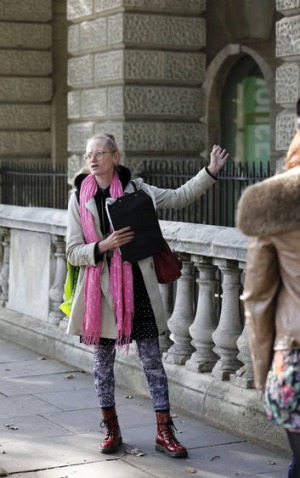
Walking tours guided by London's homeless offer a rare insight into the city's character, writes Beatrice Debut.
Like many other Londoners who make a living showing tourists around the city, Viv is telling a group of visitors how Waterloo Bridge was largely rebuilt by women after World War II.
But Viv, 56, is no ordinary tour guide. She is homeless - and the stairs under the bridge, which boasts majestic views of the Houses of Parliament and St Paul's Cathedral, were once her home.
"I lived there for two months," she tells the sightseers. "I had a patch made of wooden pallets, newspapers and cartons."
With a gaunt face and several missing teeth, and wearing a neat beige mackintosh that she found in the street, Norwegian-born Viv shows tourists the British capital as seen through the eyes of one of its homeless residents.
She is among half a dozen homeless guides working with Unseen Tours - a scheme launched by the volunteer network Sock Mob - weaving tales of their own lives on the streets into their walking tours.
Viv - her past means she wants to be known only by her first name - starts her tour in the Victoria Embankment Gardens on the edge of the River Thames. An imposing statue of the 19th-century industrialist William Edward Forster looks over the manicured gardens, which were Viv's home for four summers.
"That used to be my bench," she says, pointing at a family eating sandwiches nearby. "You're very safe in a park, because they close the park at night. You don't get attacked by the public."
Homeless Londoners hear about "spare" benches through word of mouth, she adds. She speaks quickly, the sweat on her brow revealing her nerves.
Viv guides the group from the bath where Charles Dickens once took a dip to a tea-hut frequented by taxi drivers for more than a century, before stopping at the Savoy Hotel to tell the story of the wooden cat that sits in its lobby.
The handsome metre-tall cat, named Kaspar, is brought out to join unlucky parties of 13 diners at the opulent hotel to make up their numbers to 14. Without pausing, she adds that up to 200 people used to sleep in the archway next to the Savoy until the authorities began fencing it off at night.
"One night we had an elderly lady," she says. "At around two or three in the morning, some kids tried to set her alight. They poured fuel on her sleeping bag and tried to set her alight. Luckily some of us heard the commotion, woke up and chased them away."
The tour group, who have so far seemed dazed by Viv's stark account of life on the streets, finally pluck up the courage to ask some questions.
"What about the hotel? I imagine they had a lot of leftover food?""It's a hotel for the rich," Viv says, without bitterness.
Paul van Beusekom, a 32-year-old bicycle designer from the Netherlands, eventually dares to ask a more personal question: how did Viv become homeless?
"My marriage broke up. I left my kids at home and moved out," she says simply, clearly unwilling to dwell on the subject. The tourists' questions dry up.
Viv has been homeless since 1997, drifting between parks and bridges when she cannot sleep on the sofas of friends and relatives.
She earns around £30 ($46) a week from her work as a guide. Unseen Tours pays her 60 per cent of the earnings from each tour - which costs £10 a ticket -plus £40 a month for transport and £20 for her telephone bill.
"It's very little, but it's still worth it," she says.
Above all, the tours give Viv a task to occupy her days and take her mind off things.
"I have something other to do than selling The Big Issue," she says.
The tours show that homeless people are not always "dossers and give-ups", says 56-year-old tourist Angie Hester, a firefighter.
Van Beusekom says that Viv's anecdotes about her own life were more interesting than the sights. "It sounds so easy to become homeless. It could happen to anybody. It's scary."
AFP